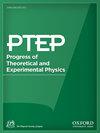SU(5) GUT 中通过 45 希格斯玻色子实现的量子耦合统一和质子衰变
IF 8.3
4区 物理与天体物理
Q1 Physics and Astronomy
引用次数: 0
摘要
我们研究了包含 45 表征希格斯场的非超对称 SU(5) 大统一理论(GUT)中的规整耦合统一(GCU)和质子衰变。我们的分析基于这样一个假设:费米子的格奥尔基-雅尔斯科格型质量矩阵负责解释奇异夸克和μ介子的质量比。考虑到 45 希格斯场的某些成分的质量远小于 GUT 尺度的可能性,我们研究了 GCU 的条件。我们发现,要满足 GCU 条件,45 希格斯场至少要有两个分量具有如此小的质量。我们搜索参数空间,在 45 希格斯玻色子的两个或三个分量分级轻的情况下,找出满足 GCU 条件的区域。如果 45 希格斯玻色子的彩色希格斯分量的质量远小于 GUT 尺度,那么通过彩色希格斯玻色子交换的质子衰变就会以可观测到的大速率发生。我们从超级卡米康德的质子衰变搜索中估计了彩色希格斯分量的质量边界,从而进一步限制了参数空间。本文章由计算机程序翻译,如有差异,请以英文原文为准。
Gauge coupling unification and proton decay via 45 Higgs boson in SU(5) GUT
We study the gauge coupling unification (GCU) and proton decay in a non-supersymmetric SU(5) grand unified theory (GUT) incorporating a 45 representation Higgs field. Our analysis is based on the assumption that Georgi-Jarlskog-type mass matrices for fermions are responsible for explaining the mass ratio of the strange quark and the muon. We examine the conditions of GCU, taking into account the possibility that certain components of the 45 Higgs field have masses much smaller than the GUT scale. We have found that to satisfy the GCU conditions, at least two components of the 45 Higgs field should have such small masses. We search the parameter space to identify regions where the GCU conditions are satisfied, in the scenarios where two or three components of the 45 Higgs boson are hierarchically light. If the colored Higgs component of the 45 Higgs boson has a mass much smaller than the GUT scale, proton decay via colored Higgs boson exchange can occur with an observably large rate. We estimate the mass bounds for the colored Higgs component from the proton decay search at Super-Kamiokande and thereby further restrict the parameter space.
求助全文
通过发布文献求助,成功后即可免费获取论文全文。
去求助
来源期刊

Progress of Theoretical and Experimental Physics
PHYSICS, MULTIDISCIPLINARY-PHYSICS, PARTICLES & FIELDS
CiteScore
12.00
自引率
5.70%
发文量
148
审稿时长
17 weeks
期刊介绍:
Progress of Theoretical and Experimental Physics (PTEP) is an international journal that publishes articles on theoretical and experimental physics. PTEP is a fully open access, online-only journal published by the Physical Society of Japan.
PTEP is the successor to Progress of Theoretical Physics (PTP), which terminated in December 2012 and merged into PTEP in January 2013.
PTP was founded in 1946 by Hideki Yukawa, the first Japanese Nobel Laureate. PTEP, the successor journal to PTP, has a broader scope than that of PTP covering both theoretical and experimental physics.
PTEP mainly covers areas including particles and fields, nuclear physics, astrophysics and cosmology, beam physics and instrumentation, and general and mathematical physics.
 求助内容:
求助内容: 应助结果提醒方式:
应助结果提醒方式:


